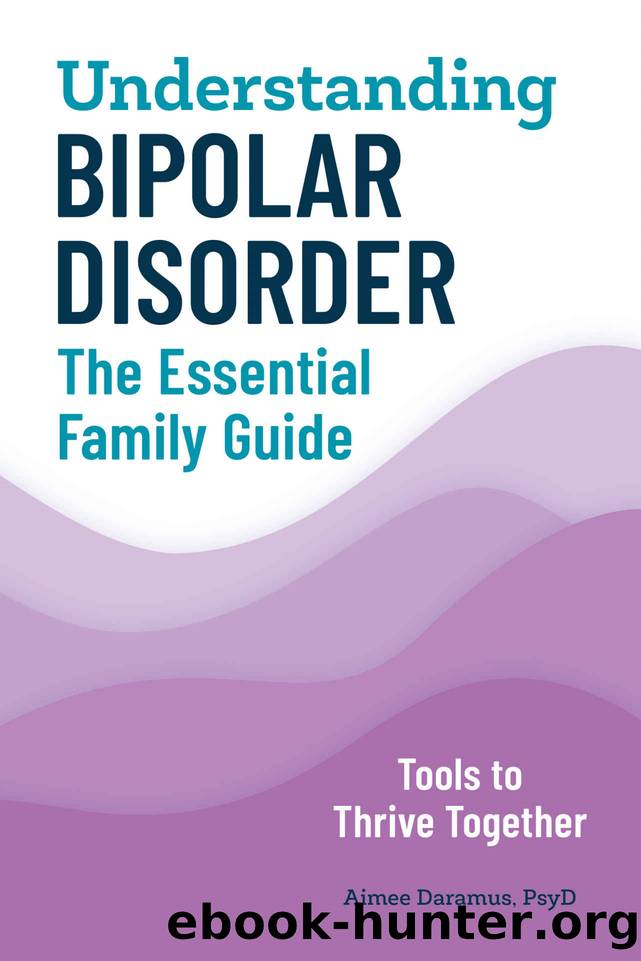Understanding Bipolar Disorder: The Essential Family Guide by Aimee Daramus PsyD

Author:Aimee Daramus PsyD [Daramus PsyD, Aimee]
Language: eng
Format: azw3
ISBN: 9781647390013
Publisher: Rockridge Press
Published: 2020-09-01T00:00:00+00:00
Managing Medication
Medications need to be monitored frequently at first, so that the prescriber can find the lowest possible dose that will still be effective. If medications are being managed outside the hospital, expect weekly blood tests as well as phone calls or emails regarding blood test results. Weekly in-person appointments are a possibility, too. Because each personâs response to medication is individual and hard to predict, itâs common to switch medications a few times if something isnât working or the side effects are too difficult. Use the chart to track changes in symptoms and side effects. If there are any tremors, severe weakness or dizziness, or totally unexpected problems, get in touch with the doctor immediately or follow their directions for emergencies.
What Itâs Like to Be on Medication
Jaden had bipolar I. He went to the hospital with acute mania that included psychotic symptoms. He couldnât sleep and the staff had a hard time getting their work done when he was around, because he constantly interrupted them to talk about anything and everything. He even ate while pacing the floor for a few days, because sitting down for more than a minute was too difficult. That led to agitation with some of the other patients; he responded with a grandiose level of anger and entitlement when anyone tried to talk to him about it. His psychiatrist gave him a âloading doseâ of a mood stabilizer to get control of the symptoms. It worked, but he began having severe side effects, including tremors, and his next blood test revealed near-toxic levels of the medication. The dosage was lowered and adjusted over the next few days, and he was released. Weekly blood tests continued for a while; eventually he only had to get a blood test once a month, and later only every few months.
Cristina, a woman on the same unit, came in with suicidal depression so severe that she had to be sedated for her own safety and watched by a staff member 24â7 for a few days until an antidepressant took effect. She started to show improvement and began to attend groups and make friends with other patients. But she became easily angered and frustrated. She drew all over the walls of her room with a marker she stole from the activity therapist. She was frustrated when staff were upset about it. She tried to explain her artistic vision, but her words made no sense.
Cristina slept for maybe two or three hours each night. A nurse let the psychiatrist know that Cristina appeared to be having a manic episode. This was the first sign that she actually had bipolar disorder instead of depression. Two different mood stabilizers failed to work, so the doctor switched her to an anticonvulsant. Cristinaâs mania finally began to calm down. Her doctor added an antipsychotic to address her unrealistic thinking and illogical speech. After a week she showed improvement, with only mild side effects. In total, it took slightly more than a month in the hospital
Download
This site does not store any files on its server. We only index and link to content provided by other sites. Please contact the content providers to delete copyright contents if any and email us, we'll remove relevant links or contents immediately.
Should I Stay or Should I Go? by Ramani Durvasula(7435)
Why We Sleep: Unlocking the Power of Sleep and Dreams by Matthew Walker(6363)
Fear by Osho(4496)
Flow by Mihaly Csikszentmihalyi(4493)
Rising Strong by Brene Brown(4195)
Why We Sleep by Matthew Walker(4193)
How to Change Your Mind by Michael Pollan(4115)
Too Much and Not the Mood by Durga Chew-Bose(4097)
The Hacking of the American Mind by Robert H. Lustig(4092)
Lost Connections by Johann Hari(3929)
He's Just Not That Into You by Greg Behrendt & Liz Tuccillo(3719)
Evolve Your Brain by Joe Dispenza(3506)
The Courage to Be Disliked by Ichiro Kishimi & Fumitake Koga(3264)
Crazy Is My Superpower by A.J. Mendez Brooks(3208)
What If This Were Enough? by Heather Havrilesky(3199)
Resisting Happiness by Matthew Kelly(3197)
Descartes' Error by Antonio Damasio(3168)
The Book of Human Emotions by Tiffany Watt Smith(3145)
In Cold Blood by Truman Capote(3141)
